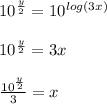Answer:
Assuming log is the natural logarithm:

Assuming log is the base 10 logarithm:

Explanation:
Assuming log is the natural logarithm:
First step: Replace f(x) with y that is


Second step: Solve for x:


Third step: Replace every x with a y and replace every y with an x:

Final step: Replace y with
 :
:

Assuming log is the base 10 logarithm:
It is the same procedure as before, the only thing that change, is when we are solving for x:
First step: Replace f(x) with y that is


Second step: Solve for x:


Third step: Replace every x with a y and replace every y with an x:

Final step: Replace y with
 :
:
